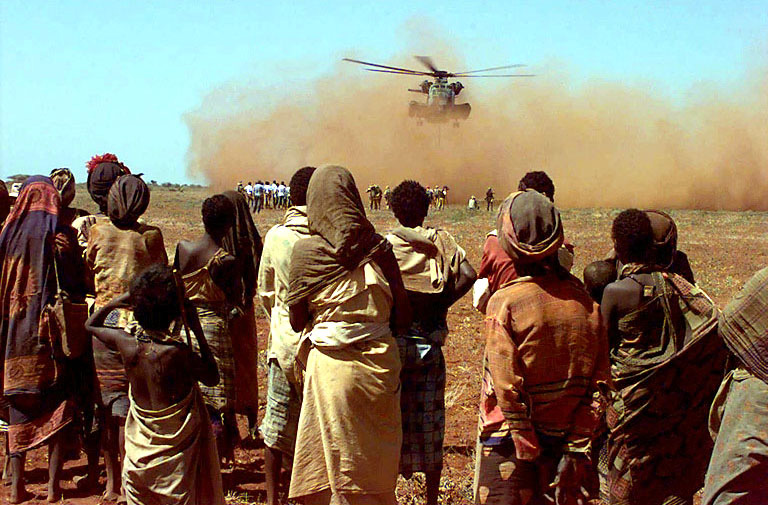Black Hawk Down: The Mogadishu Operation

US Marine Corps CH-53 Sea Stallion delivers aid to the village of Maleel (January 1993).
SUMMARY
Mogadishu. Just the name itself is enough to send a ripple of unease. Black Hawk Down, otherwise known as the Battle of Mogadishu was one of the most significant battles of recent military history.
On October 3, 1993, a group of U.S. Army Rangers, Delta Force operators, and Somali militiamen launched a nighttime raid on a fortified compound in the capital city of Mogadishu. The raid's target was a warlord - Mohamed Farrah Aidid. The intel community suspected he was responsible for attacks on UN peacekeepers. The mission quickly went awry when Somali forces shot down three American Sikorsky UH-60 Black Hawk helicopters using RPGs. Two of the helos crashed deep into hostile territory. American forces found themselves trapped in a city full of fighters. In the ensuing firefight, 18 Americans were killed and more than 70 were wounded. It was the deadliest day for U.S. forces since the Vietnam War.
The Mogadishu battle was chronicled in a best-selling book (and later a movie) called "Black Hawk Down." After, American troops withdrew from Somalia. Later, the DoD reassessed the U.S.'s role in peacekeeping operations worldwide.
How had a routine mission to capture a Somali warlord become such a disaster? And what did it mean for America's future involvement in Somalia?
Why Was the Operation Launched?
In 1992, a civil war broke out in Somalia after the overthrow of President Siad Barre. The country descended into lawlessness, and rival warlords began vying to control critical cities and resources. To restore order, the United Nations dispatched a peacekeeping force to Somalia in early 1993.
However, conditions on the ground continued to deteriorate. That summer, two American helicopters were shot down in Mogadishu. Additionally, several UN workers were killed in attacks. All signs pointed to Aidid and his militiamen. In response, the UN Security Council authorized the capture or killing of those responsible for the attacks.
The U.S., which had already supported the UN peacekeeping mission, now became directly involved in efforts to apprehend Aidid. On October 3rd, 1993, a group of Army Rangers and Delta Force operators raided one of Aidid's compounds. They captured two of his lieutenants.
What Went Wrong?
Almost everything that could go wrong did go wrong during the operation. Obstacles and heavy gunfire delayed the Ranger unit. In turn, the landing zone was not secure. So this allowed Somali militiamen to mass around them. An RPG hit a Black Hawk helicopter. It crashed shortly after impact. Several other helicopters also came under attack.
As American forces fought their way towards their objectives—and evacuated their wounded comrades—they became increasingly surrounded by hostile gunmen. The Rangers barely had enough ammo. No reinforcements were coming, either. So, they finally retreated back to their base under cover of darkness.
In Somalia today, a small number of American troops (approximately 500) are present. The United States has continued to provide humanitarian assistance to Somalia throughout the years. Black Hawk Down serves as an important reminder of the risks inherent in peacekeeping missions. It's a further reflection of America's commitment to restoring order in regions engulfed by violence.
What Happened After Black Hawk Down?
The DoD launched an investigation immediately into the Mogadishu incident. It didn't take long to discover "a serious failure of intelligence." The mission had been based on false information. Sadly, American forces didn't have what they needed to succeed. They also didn't expect the level of resistance they would encounter. The U.S. government pledged to never again put American troops in harm's way without ensuring they had all the necessary resources to succeed.
In Somalia, the immediate aftermath of Mogadishu was a return to chaos. Without the stabilizing presence of American troops, rival warlords resumed their fighting. Once again, civilians became caught in the crossfire. Hundreds of thousands of Somalis fled their homes in search of safety. In 1997, a new Somali government finally restored some semblance of order to the country, but peace remains elusive even today.
Lessons Learned from Mogadishu
As for America's involvement in Somalia, the events of October 3 served as a stark reminder of the dangers of nation-building. In the years that followed, American troops deployed elsewhere. The difference in those deployments was that there was a much clearer exit strategy than there had been in Somalia. The debacle in Mogadishu also reassessed America's role in the world.
The Battle of Mogadishu was a watershed moment for America's military and foreign policy. It led to a reassessment of America's role in the world. In Somalia, it led to a return to chaos. However, a new government was eventually able to restore some order to the country, peace remains elusive even today.
Read more about the Ranger who fought in this battle and then went on to become a celebrity here.
SHARE
